| Oracle Park | |
|---|---|
 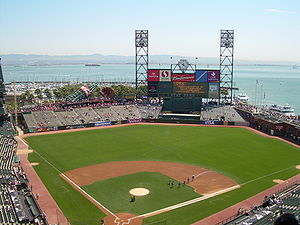 | |
| Location | 24 Willie Mays Plaza San Francisco, California |
| Opened | March 31, 2000 |
| Owner | China Basin Ballpark Corp. |
| Operator | San Francisco Baseball Associates LP |
| Surface | Grass |
| Construction cost | $357 million ($537 million in 2020 dollars) |
| Former names | Pacific Bell Park (2000-2003) SBC Park (2004-2005) AT&T Park (2006-2018) |
| Tenants | |
| San Francisco Giants (MLB) (2000-present) California Golden Bears (NCAA) (2011) | |
| Capacity | |
| 40,930 (2000) 41,059 (2001-03) 41,403 (2003-04) 41,584 (2005) 41,606 (2006) 41,915 (2007-present) | |
| Dimensions | |
| Left field line – 339 feet (103m) Left field – 364 feet (111m) Left-center field – 404 feet (123m) Center field – 399 feet (122m) Right-center field – 421 feet (128m) Right field – 365 feet (111m) Right field line – 309 feet (94m) | |
AT&T Park is a ballpark located in the China Basin neighborhood of San Francisco, California. Located at 24 Willie Mays Plaza, at the corner of Third and King Streets, it has served as the home of the San Francisco Giants of Major League Baseball since 2000. Previously named Pacific Bell Park, SBC Park, and AT&T Park, the stadium's current name was purchased by the Oracle Corporation in 2019.[1]
The stadium stands along San Francisco Bay; the section of the bay beyond Oracle Park's right field wall is unofficially known as McCovey Cove, in honor of former Giants player Willie McCovey.
Oracle Park has also hosted professional and collegiate American football games. The stadium was the home of the annual college postseason bowl game now known as the Redbox Bowl from its inaugural playing in 2002 until 2013, and also served as the temporary home for the University of California's football team in 2011. Professionally, it was the home of the San Francisco Demons of the XFL and the California Redwoods of the United Football League.
History[]
Design and construction[]
Originally designed to be a 42,000-seat stadium, there were slight modifications before the final design was complete. When the ballpark was brought to the ballot box in the fall of 1996 for voter approval, the stadium was turned 15° clockwise from its current position. Also the center-field scoreboard was atop the right-field wall and the Giants Pavilion Building were two separate buildings.[2] Groundbreaking on the ballpark began on December 11, 1997, in the industrial waterfront area of San Francisco known as China Basin in the up-and-coming neighborhoods of South Beach and Mission Bay. The stadium cost $357 million to build and supplanted the Giants' former home, Candlestick Park, a multi-use stadium in southeastern San Francisco that was also home to the NFL's San Francisco 49ers until 2014, when they relocated to Levi's Stadium in Santa Clara. A team of engineers from the University of California at Davis was consulted in the design process of the park, resulting in wind levels that are approximately half those at Candlestick. Fans had shivered through 40 seasons at "The 'Stick" and looked forward to warmer temperatures at the new ballpark.[3] But because Oracle Park, like its predecessor, is built right on San Francisco Bay, cold summer fog and winter jackets in July are still not unusual at Giants games, despite the higher average temperature.
When it opened on March 31, 2000, the ballpark was the first MLB ballpark built without public funds since the completion of Dodger Stadium in 1962.[4] However, the Giants did receive a $10 million tax abatement from the city and $80 million for upgrades to the local infrastructure (including a connection to the Muni Metro).[5] The Giants have a 66-year lease on the 12.5-acre (51,000 m2) ballpark site, paying $1.2 million in rent annually to the San Francisco Port Commission.[4] The park opened with a seating capacity of 40,800, but this has increased over time as seats have been added. In April 2010, the stadium became the first MLB ballpark to receive LEED Silver Certification for Existing Buildings, Operations and Maintenance.[6]
Following the 2019 season, the organization began the process of relocating the bullpens from the first- and third base foul lines to behind the outfield walls in center and right-centerfield. The motivation was two-fold: to address player safety issues that had arisen over the years by having the bullpen mounds in the field of play, and to slightly alter the dimensions of the park to perhaps increase, if ever-so-slightly, the potential for home runs in certain areas of the outfield,[7] most notably in right-center field, affectionately known as Triples Alley (a design feature meant as an homage to the centerfield depth of the Giants former home in New York, The Polo Grounds). Prior to these modifications, multiple players both home and away had experienced various levels of injury sustained by tripping over the bullpen mounds while chasing foul balls. Most notably, former Giants outfield prospect Mac Williamson sustained a concussion during such a play that significantly altered his season.[8]
Naming rights[]
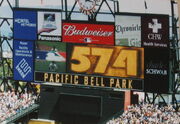
Barry Bonds passes Harmon Killebrew for seventh on the all-time home run list on May 13, 2002.
On April 3, 1996, Pacific Bell, a telephone company serving California based in San Francisco, purchased the naming rights for the planned ballpark for $50 million for 24 years. The stadium was named Pacific Bell Park, or Pac Bell Park for short.[9]
Just days before the sponsorship was announced, SBC Communications had announced their intention to acquire Pacific Bell's parent company, Pacific Telesis, a deal which closed in April 1997. SBC eventually stopped using the Pacific Bell name for marketing, and reached an agreement with the Giants to change the stadium's name to SBC Park on January 1, 2004.[9]
After SBC bought AT&T Corporation on November 18, 2005, the name of the merged company became AT&T Inc. As a result, in 2006 the stadium was given its third name in six years: AT&T Park.[9]
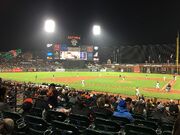
A Giants’ night game on September 25, 2018 vs. the San Diego Padres from a lower level view at Oracle Park
On January 9, 2019, it was reported that AT&T had given the Giants the option of ending the naming deal a year early, if the team could quickly find a new partner.[10] The Giants and Oracle Corporation came to a rapid agreement, with the old AT&T Park signs being replaced with temporary Oracle Park banners on January 10.[11]
2020 renovations[]
The Giants renovated the center field section of Oracle Park between October 2019 and June 2020.[12][13] The bullpens were moved from foul territory into center field, so the Giants decided to make their garden smaller to fit the bullpens behind the center-field wall. With this renovation, the dimensions of the park have slightly shrunk. Left-center was trimmed down from 404 feet to 399 feet, right-center (known as Triples Alley) was trimmed down from 421 feet to 415 feet (to represent the San Francisco area code), and dead-center was trimmed down the 399 feet to 391 feet, making it the second shortest dead-center field distance in MLB, behind only Fenway Park in Boston.[14] With this renovation, approximately 650 bleacher seats had to be removed, so the two terraces could be built for fans to watch the relief pitchers warm-up from up close.[15] The center field wall shortened from eight feet to seven feet, but after the Giants first exhibition of the 2020 season, the dead-center field part of the wall (covering the garden) was raised from seven feet to ten feet to improve visibility to the hitter.[16]
Despite having the unique moniker of the least home-run friendly field over several seasons prior to the renovations, it's believed that these renovations were made to increase home run output from the Giants. The MLB has seen a surge in home run production in recent years, and the Giants consistently ranked well towards the bottom in this category in large part because of Oracle Park's extreme advantage to pitchers. This hurt the run production of Giants players and also discouraged power hitters from wanting to play for the Giants. From 2017 to 2019, one of the common criticisms of the Giants was their lack of offensive output and unwillingness to adjust to a home run-heavy offense. However, the Giants significantly improved in 2020, the first year the dimensions were moved in. Things would trend upward with a massive bounce-back season in 2021; several Giants such as Brandon Belt and Mike Yastrzemski fueled the offense with more home runs, especially to a shortened triple's alley (which was infamous for turning what would be a long HR in several ballparks into deep 420-foot+ flyouts, killing several promising San Francisco scoring opportunities in the past). Oracle Park still ranks towards the bottom of the home run category, but this designation is not as consistent anymore.
Features[]

The 24-foot (7.3 m) high wall in right field
The stadium contains 68 luxury suites, 5,200 club seats on the club level and an additional 1,500 club seats at the field level behind home plate.
On the facing of the upper deck along the left field line are the retired numbers of Bill Terry, Mel Ott, Carl Hubbell, Monte Irvin, Willie Mays, Juan Marichal, Orlando Cepeda, Jackie Robinson, Willie McCovey, and Gaylord Perry as well as the retired uniforms, denoted "NY", of Christy Mathewson and John McGraw who played or managed in the pre-number era. These two pre-number era retired uniforms are among only six such retired uniforms in all of the Major Leagues.
Right field and McCovey Cove[]
The most prominent feature of the ballpark is the right field wall, which is 24 feet high in honor of former Giant Willie Mays, who wore number 24. Because of the proximity to the San Francisco Bay, the right field foul pole is only 309 feet from home plate. The wall is made of brick, with fenced off archways opening to the Cove beyond, above which are several rows of arcade seating. The fence angles quickly away from home plate; right-center field extends out to 421 feet from home plate. Atop the fence are four pillars with fountains atop. These four pillars will burst jets of water when the Giants hit a home run, win a game, and at the end of the National Anthem.
The 2nd, digital version of the "Splash Hit" counter on the right field wall
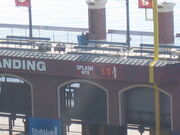
The 50 "Splash Hit" counter
In the past, rubber chickens put up by fans whenever a Giants player (especially Barry Bonds) was intentionally walked, would line the foul portion of the wall. The fans would do this to show that the opposing team is "chicken" for not pitching right to the Giants players. In recent seasons, as the team's strength has shifted from hitting to pitching, fans will line up "K" signs with each strikeout by a Giants pitcher. To some seniors, the right field area vaguely suggests the layout at the Polo Grounds. This deep corner of the ballpark has been dubbed "Death Valley" and "Triples' Alley." Like its Polo Grounds counterpart, it is very difficult to hit a home run to this area, and a batted ball that finds its way into this corner often results in a triple. Triples' Alley is also infamous for bad bounces, most notably when Ichiro Suzuki hit the first-ever inside the park home run in an All-Star Game by lining the ball off one of the archways and sideways past the outfielders. Nate Schierholtz performed the same feat in the 2009 season as a pinch hitter. Aubrey Huff did it again in the 2010 season.
Beyond right field is China Basin, a section of San Francisco Bay, which is dubbed McCovey Cove after famed Giants first baseman and left-handed slugger Willie McCovey, and into which a number of home runs have been hit on the fly. As of September 27, 2011, 60 "splash hits" have been knocked into the Cove by Giants players since the park opened; 35 of those were by Barry Bonds. Opponents have hit the water on the fly 23 times; Todd Hundley of the Los Angeles Dodgers was the first visitor to do so on June 30, 2000. Luis Gonzalez of the Arizona Diamondbacks and Cliff Floyd of the Chicago Cubs are the only visiting players to do so twice, while Carlos Delgado of the New York Mets has performed the feat three times. Adam LaRoche has also hit three splash hits, twice with the Arizona Diamondbacks and once with the Pittsburgh Pirates. Rick Ankiel of the Atlanta Braves most recently hit one into the water - a come-from-behind solo home run in the 11th inning of game 2 of the 2010 NLDS. Barry Bonds is the Giant who has hit the most home runs into "The Cove" as Giants fans call it.[17]
Behind the scoreboard in center field there is a pier where ferries can tie up and let off fans right at the park. On game days, fans take to the water of McCovey Cove in boats and even in kayaks, often with fishing nets in the hope of collecting a home run ball. (This echoes what used to happen during McCovey's playing days. Before Candlestick Park's upper deck was extended, the area behind right field was occupied by three small bleacher sections and a lot of open space. Kids in those bleachers would gather behind the right field fence when "Stretch" would come to the plate). Just beyond the wall is a public waterfront promenade, where fans can watch three innings of a game through the wall's archways, free of charge, albeit with a somewhat obstructed view. Across the cove from the ballpark is McCovey Point and China Basin Park, featuring monuments to past Giants legends.
Rusty, the Coke bottle, and the glove[]
When the park opened in 2000, taking residence on the right field wall was Rusty, the Mechanical Man based on a theme of Old Navy since the wall was sponsored by the company. Rusty was a two-dimensional robotic ballplayer that stood 14 feet tall and weighed five and a half tons. The Valencia, California firm, Technifex, engineered, fabricated and programmed Rusty to appear after major plays, during games, as a fully animated giant 1920's era tin "toy". After technical problems arose with Rusty, it was removed from the Old Navy Splash Landing, though the enclosure that housed him remained for years. In 2006 the Old Navy sponsorship of the wall was terminated and renamed "Levi's Landing". In 2008, the enclosure was removed as that area near the right field foul pole was renovated for a new luxury party suite called the "McCovey Cove Loft".[18]
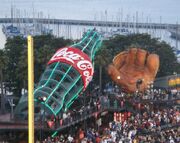
The Coca-Cola bottle and old-fashioned glove
Behind the left field bleachers is "The Coca-Cola Fan Lot". The ballpark features an 80 feet long Coca-Cola bottle with playground slides that will blow bubbles and light up with every Giants home run, and a miniature version of the stadium. "The Coca-Cola Superslide" is popular with children as is with adults, and the terraced levels of the slides is a fun way to catch the game. If one were viewing the outfield promenade from home plate, directly to the bottle's right is another oversized representation of a ballpark stalwart, the "Giant 1927 Old-Time Four-Fingered Baseball Glove" — this particular one is made of steel and fiberglass. Behind and further to the left is "The Little Giants Park" - a miniature baseball diamond — sort of a minor league tryout for Pee-Wee Ball.[19]
To the right of the glove sculpture is the elevator and large plaza area for functions and parties to be held during games. It's also the site of "Orlando's", the concession stand of Giants great Orlando Cepeda. The signature fare at the stand is the "Caribbean Cha Cha Bowl". Right-center field features a real San Francisco cable car (retired cable car #4, formerly #504), with a label that states "No Dodgers Fans Allowed". The fog horn — a feature introduced at Candlestick Park by the current Giants ownership group - was transferred to Oracle and hung underneath the scoreboard. It blows when a Giants player hits a home run or at the conclusion of a Giants win. Continuing right takes one to the promenade above the Cove, so that one can make a completely uninterrupted circuit of the park at that concourse level. Both levels of the concourse, inside the stadium, feature not only concession stands of all sorts, but other attractions as well.
"Lou Seal" store[]
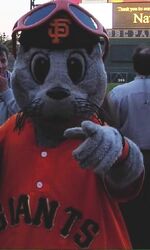
Lou Seal has served as mascot of the San Francisco Giants since 1996.
The ballpark features a make-your-own-mascot store for the Giants' mascot, Lou Seal.
Scoreboards[]
In addition to the automated scoreboards, which now include a new high-definition video board by Mitsubishi, the park has enormous, manually operated boards on the right field wall, which display the scores of Major League games played elsewhere. These manual scoreboards are operated by three employees, whose work on game days starts at least two hours before the first pitch.
Wireless internet[]
Starting in 2004, the Giants installed one hundred twenty-two 802.11b wireless internet access points, covering all concourses and seating areas, creating one of the largest public hotspots in the world[20] at the time.
San Francisco Giants Wall of Fame[]
On September 23, 2008, the Giants Wall of Fame was unveiled on the King Street side of the ballpark.[21] Eligibility requirements for players to be on the Wall are either 5 years as a Giant with an All Star Game appearance or 9 years as a Giant.[22] Rich Aurilia and Shawn Estes were added in 2010.[23] In 2011, the Giants announced that pitcher Jason Schmidt and outfielder Marvin Benard would be added in an August 27, 2011 ceremony.[24]
Statues[]
Outside the ballpark are five statues, four of which are dedicated to San Francisco Giants all-time greats.
The Willie Mays Statue is located in front of the ballpark entrance at 24 Willie Mays Plaza and is surrounded with 24 palm trees, in honor of his number 24 uniform, retired by the Giants. It was dedicated at noon on March 31, 2000, prior to the opening of the ballpark and was commissioned by then Giants Managing Partner Peter Magowan and his wife Debby.[25]
Another statue is located at McCovey Point across McCovey Cove, and is dedicated to Willie McCovey. Around the Willie McCovey Statue are a number of plaques that celebrate the winners of the Willie Mac Award. The statue is located at China Basin Park next to The Barry Bonds Junior Giants Field, a T-ball park. Also located on the sea wall promenade are plaques showing the Opening Day Roster of every Giants team from 1958 through 1999. Giants fans who contributed funds to China Basin Park, had their own tiles with their own inscriptions set into the wall.[26]
A third statue, dedicated in 2005, honors former Giants pitcher Juan Marichal, and is located outside the ballpark at the Lefty O'Doul Gate entrance.
The fourth statue is located at the park's ferry plaza behind center field, also known as Seals Plaza; a statue of a seal bobbing a baseball on its nose honors the memory of the San Francisco Seals, the minor league baseball club that played in San Francisco before the arrival of the Giants in 1958.
On September 6, 2008, during a series against the Pittsburgh Pirates, a fifth statue depicting former Giants great Orlando Cepeda was dedicated at the corner of 2nd and King Streets next to the ballpark. All four statues of the Giants Hall of Fame players were created by sculptor William Behrends of North Carolina.
In 2006 the Giants added a plaque for Eddie Grant, a former Giants' player who was killed fighting in France on October 5, 1918. The original plaque was mounted in deep center field of the Polo Grounds in New York, and after the final game that the Giants played there, the plaque disappeared. The Giants created a plaque very similar to the original, and it is now on display in the spectator area near the center field scoreboard.
References[]
- ↑ Keeling, Brock (January 9, 2019). AT&T Park is now called Oracle Park.
- ↑ Epstein, Edward. "The Giants' Grand Designs / Statue of Willie Mays to Grace New Ballpark", February 25, 1997.
- ↑ Engineering: Taking the Wind Out of Baseball. UC Davis Magazine.
- ↑ 4.0 4.1 "Privately Built Pacific Bell Park a Curse to Other Teams", October 22, 2002.
- ↑ Gordon, Jon (May 14, 2004). In San Francisco, the Giants Went Private for Their Stadium. Minnesota Public Radio.
- ↑ Major League Baseball Advanced Media (April 21, 2010). AT&T Park Becomes the First Major League Ballpark to Receive LEED Silver Certification for Existing Buildings, Operations and Maintenance. Press release.
- ↑ Giants announce Oracle Park changes with new dimensions (December 12, 2019).
- ↑ Cavalieri, Dom (February 26, 2019). Mac Williamson on concussion last season: 'I had never endured some of the things I endured last year in my life' (en-US).
- ↑ 9.0 9.1 9.2 Raine, George. "It's Official: SBC Park Becomes AT&T March 1 / S.F. Giants Will Be Playing Ball on Field's Second Name Change Since Opening in 2000", February 4, 2006.
- ↑ Haft, Chris. "Giants, Oracle agree to naming rights deal", MLB Advanced Media, January 9, 2019.
- ↑ Schulman, Henry. "SF Giants' home now called Oracle Park after AT&T split", January 9, 2019.
- ↑ Construction Updates. San Francisco Giants (December 12, 2019). Retrieved on August 2, 2021.
- ↑ Check out first look at Giants' new completed bullpens at Oracle Park. NBC Sports Bay Area (June 30, 2020). Retrieved on August 2, 2021.
- ↑ Oracle Park's new dimensions. SB Nation (December 11, 2019). Retrieved on May 7, 2021.
- ↑ Giants announce changes to Oracle Park, move bullpens to outfield. NBC Sports Bay Area (December 12, 2019). Retrieved on August 2, 2021.
- ↑ Why Giants raised Oracle Park center field wall to 10 feet last week. NBC Sports Bay Area (July 28, 2020). Retrieved on August 2, 2021.
- ↑ Splash Hits. SFGiants.com. Retrieved on 2007-09-18.
- ↑ Oracle Park's new McCovey Cove Loft "Suite Of Dreams Debuts At AT&T Park" March 7, 2008
- ↑ Ballpark Attractions
- ↑ http://mlb.mlb.com/sf/ballpark/wifi.jsp#wifi
- ↑ Giants Honor Greats with Wall of Fame
- ↑ Giants to Unveil 'Wall of Fame'
- ↑ Aurilia, Estes to Join Giants Wall of Fame
- ↑ Schmidt, Benard Set for Wall of Fame
- ↑ sfgate.com 'ALL CHOKED UP / Giants legend Willie Mays is moved by statue of him for new ballpark' August 7, 1998
- ↑ San Francisco Giants McCovey Point And China Basin Park
External links[]
| Current ballparks in Major League Baseball | ||
| National League | American League | |
|---|---|---|
| American Family Field | Busch Stadium | Chase Field | Citi Field | Citizens Bank Park | Coors Field | Dodger Stadium | Great American Ball Park | Loan Depot Park | Nationals Park | Oracle Park | PETCO Park | PNC Park | Truist Park | Wrigley Field | Angel Stadium | Comerica Park | Fenway Park | Globe Life Field | Guaranteed Rate Field | Kauffman Stadium | Minute Maid Park | Oriole Park at Camden Yards | Progressive Field | RingCentral Coliseum | Rogers Centre | T-Mobile Park | Target Field | Tropicana Field | Yankee Stadium | |

